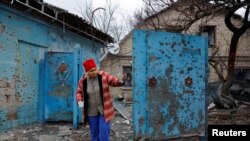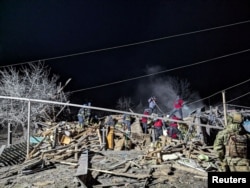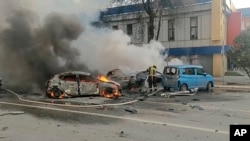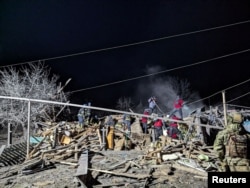A deadly Russian missile strike hit the eastern Ukrainian city of Pokrovsk on Saturday, about 80 kilometers (50 miles) northwest of Donetsk, the governor of the Ukrainian-held part of the region, Vadym Filashkin, wrote on the Telegram messaging app.
"Eleven dead, including five children — these are the consequences for now of strikes on Pokrovsk district," Filashkin said, posting pictures of rescue squads sifting through large piles of smoldering rubble in the dark along with a burned-out vehicle.
Filashkin said S-300 missiles had been used in a series of Russian attacks, with the main strike hitting Pokrovsk and nearby villages. He said the attack showed Russian forces were "trying to inflict as much grief as possible on our land."
The Kharkiv region prosecutor's office provided evidence Saturday indicating Russia may have attacked Ukraine with missiles supplied by North Korea.
Examining fragments of one of several missiles that hit the city of Kharkiv on January 2, Dmytro Chubenko, spokesperson for the prosecutor's office, said it was visually and technically different from Russian models.
Chubenko declined to provide the missile's exact model name but showed remnants of the missile to reporters and said its production method was not very modern, and it differed from the standard Iskander missiles that had previously struck Kharkiv.
"This missile is similar to one of the North Korean missiles," Chubenko said, adding that the missile's diameter was slightly larger than a Russian Iskander missile and its nozzle, internal electrical wiring and rear parts were different.
"That is why we are leaning toward the version that this may be a missile which was supplied by North Korea," he said.
A senior adviser to Ukrainian President Volodymyr Zelenskyy alleged Friday that Russia hit Ukraine this week with missiles supplied by North Korea for the first time since its invasion in February 2022.
Russia attacked Kharkiv with several missiles this week, killing two people and injuring more than 60 in one of its biggest missile and drone strikes since the start of the large-scale war.
Drone production
Russia plans to domestically produce more than 32,000 drones each year by 2030 accounting for 70% of its drone stockpile, the TASS news agency cited First Deputy Prime Minister Andrei Belousov as saying Saturday.
"The annual production volume of unmanned aerial vehicles [UAVs] — excluding educational UAVs — is planned at 32,500 units," Belousov told TASS. "This is almost three times higher than current production volumes."
Russia will finance the national project on UAVs with $7.66 billion by 2030, Belousov said, and will publish more details this month.
Both Russia and Ukraine are ramping up their drone production as UAVs have been widely used by both sides since the beginning of the war.
Moscow has been using the cheaply produced, Iranian-made Shahed drones, known in Ukraine for their noisy petrol engines.
Meanwhile, Ukraine has been modifying personal civilian drones for the battlefield, a cheap but effective option for reconnaissance and attacks and a tactic Russia has adopted.
Ukraine said in December it planned to produce more than 11,000 medium- and long-range attack drones in 2024, as well as 1 million FPV — first-person-view — drones that are widely in demand on the front line.
In his nightly video address Saturday, Zelenskyy said Ukraine is working hard so it can rely mostly on Ukrainian weapons' production.
"The strength of our Ukrainian forces must be much greater. It will happen," said the president. "We will rebuff every manifestation of Russian terror, every attempt by Russia to increase its pressure on our state, our people, our positions."
Targeting Crimea
Russia's Defense Ministry said Russian air defense units intercepted and destroyed Ukrainian guided missiles over Crimea early Saturday.
It also reported that air defense units had downed drones from a series of Friday night attacks over the Crimean Peninsula and the western part of the Black Sea.
Zelenskyy had pledged to hit more targets on the Crimean Peninsula and inside Russian border regions this year, alarming Russians as President Vladimir Putin seeks reelection in March.
Casualty rates
Meanwhile, the British Defense Ministry said Saturday on social media platform X that Russia's casualties in Ukraine rose by almost 300 soldiers per day last year in its war against Ukraine.
The increase "almost certainly reflects the degradation of the Russian readiness force and their movement to a low quality, high quantity mass army."
If the casualties continue at the current rate, according to the ministry, Russia is on course to "have sustained over half-a-million personnel killed and wounded in Ukraine" by the end of 2024.
By comparison, the ministry said, the Soviet Union suffered 70,000 casualties in Afghanistan between 1979 and 1989.
On Friday, in a stark warning, U.S. President Joe Biden's top budget official said time is running out for lawmakers to replenish U.S. aid for Ukraine — with the decision bogged down in Congress over budget negotiations on immigration, where a deal has so far eluded lawmakers.
Shalanda Young, director of the Office of Management and Budget, said there is no avenue to help Ukraine, aside from Congress approving more funding for Kyiv as it tries to repel Russia in a war that is now nearly two years old.
While the Pentagon has some limited authority to help Kyiv, without new funding from Capitol Hill, "that is not going to get big tranches of equipment into Ukraine," Young underscored.
Some material for this report was provided by The Associated Press, Agence France-Presse and Reuters.












